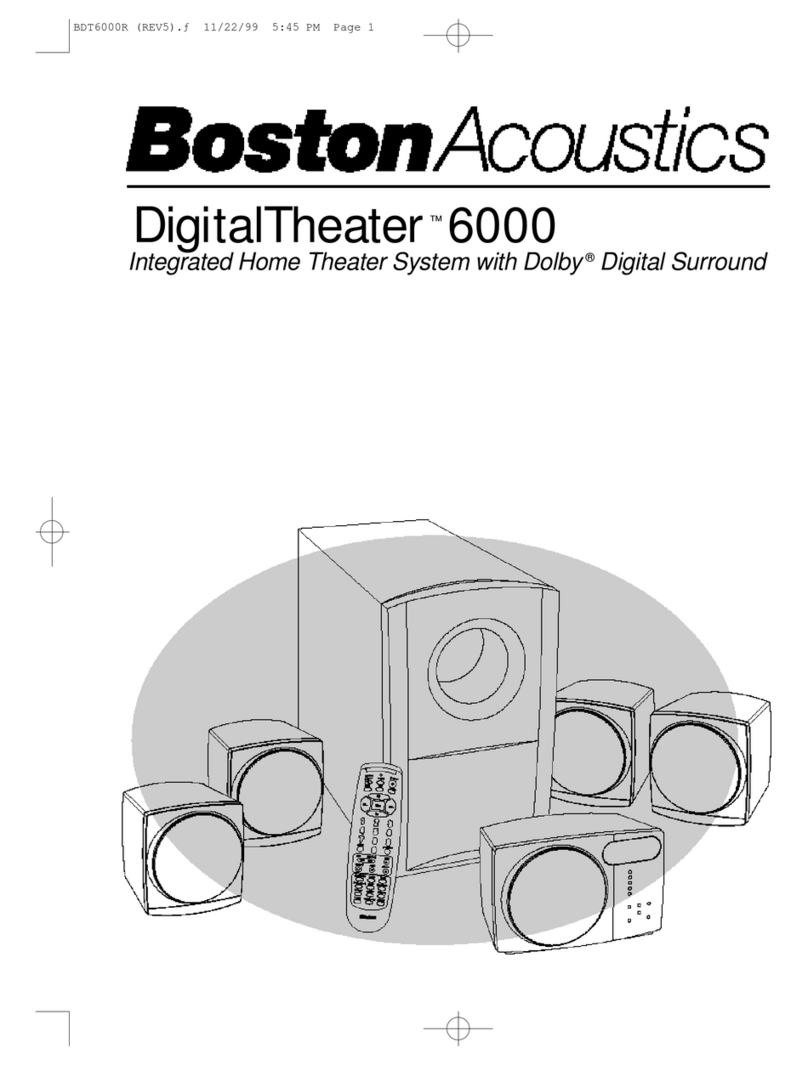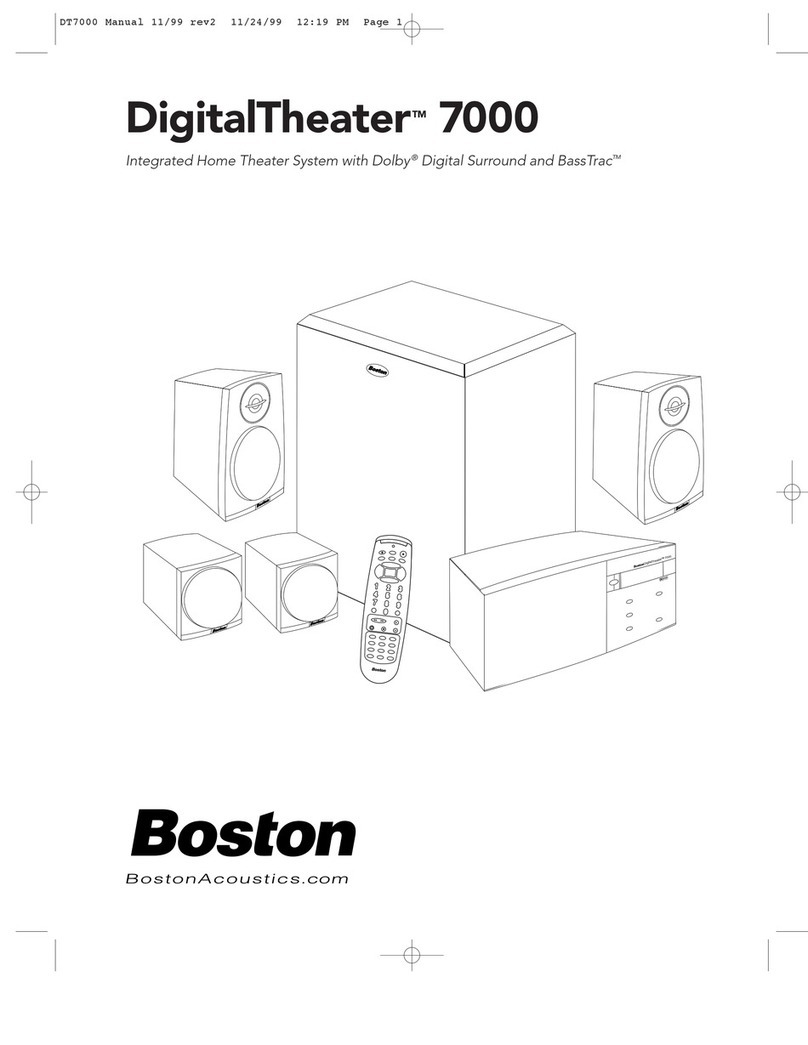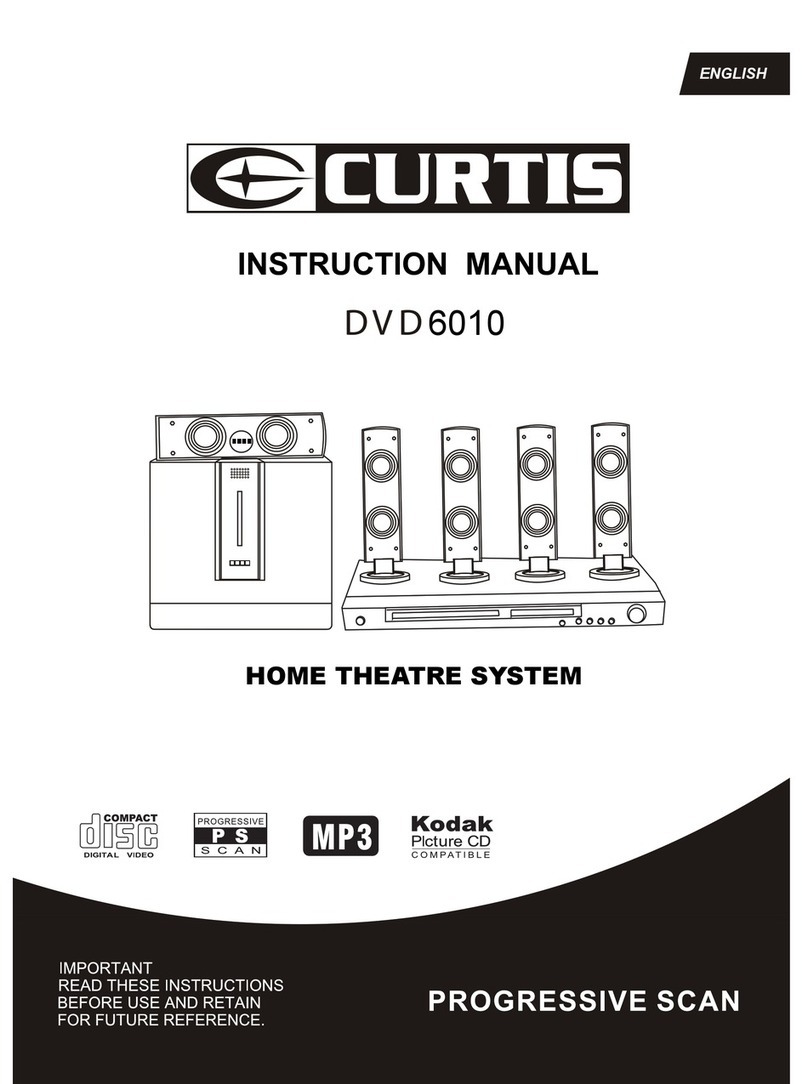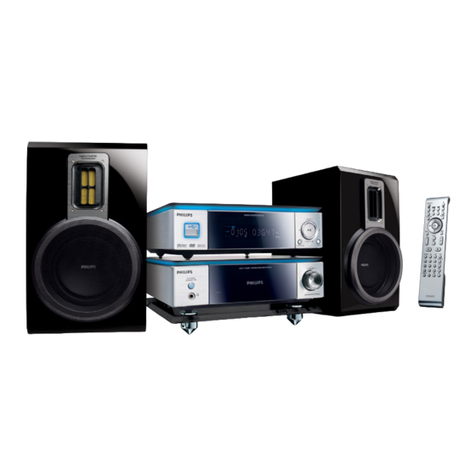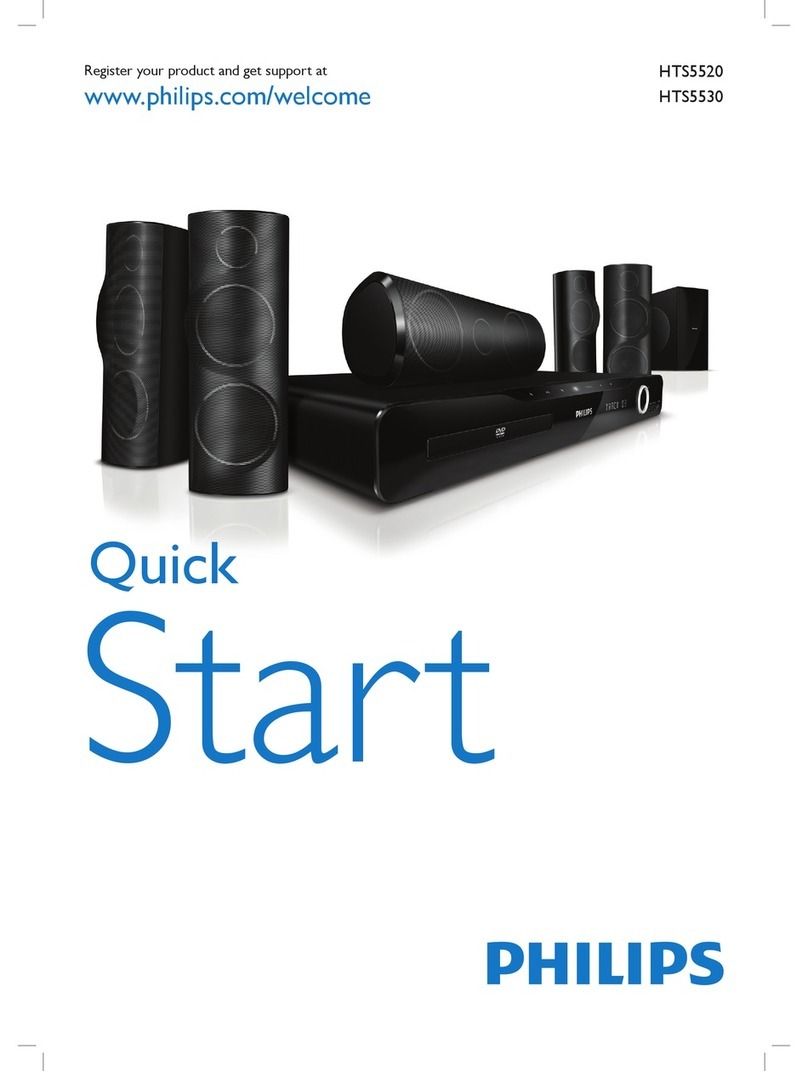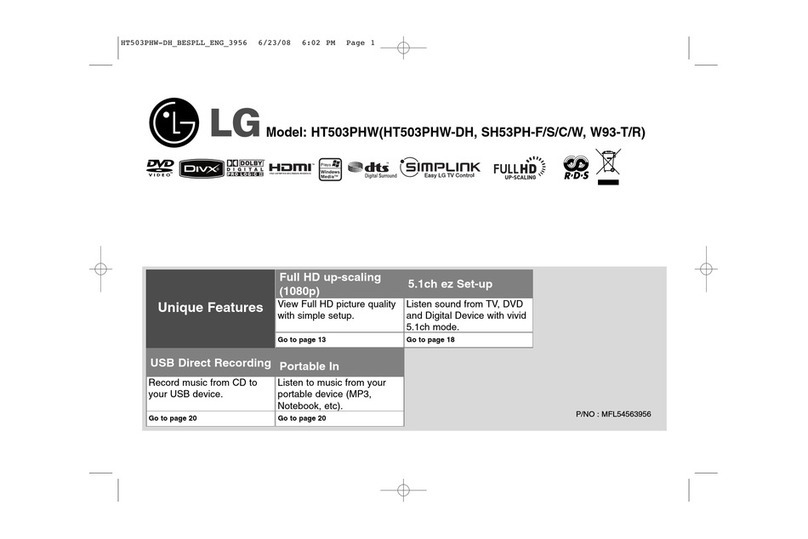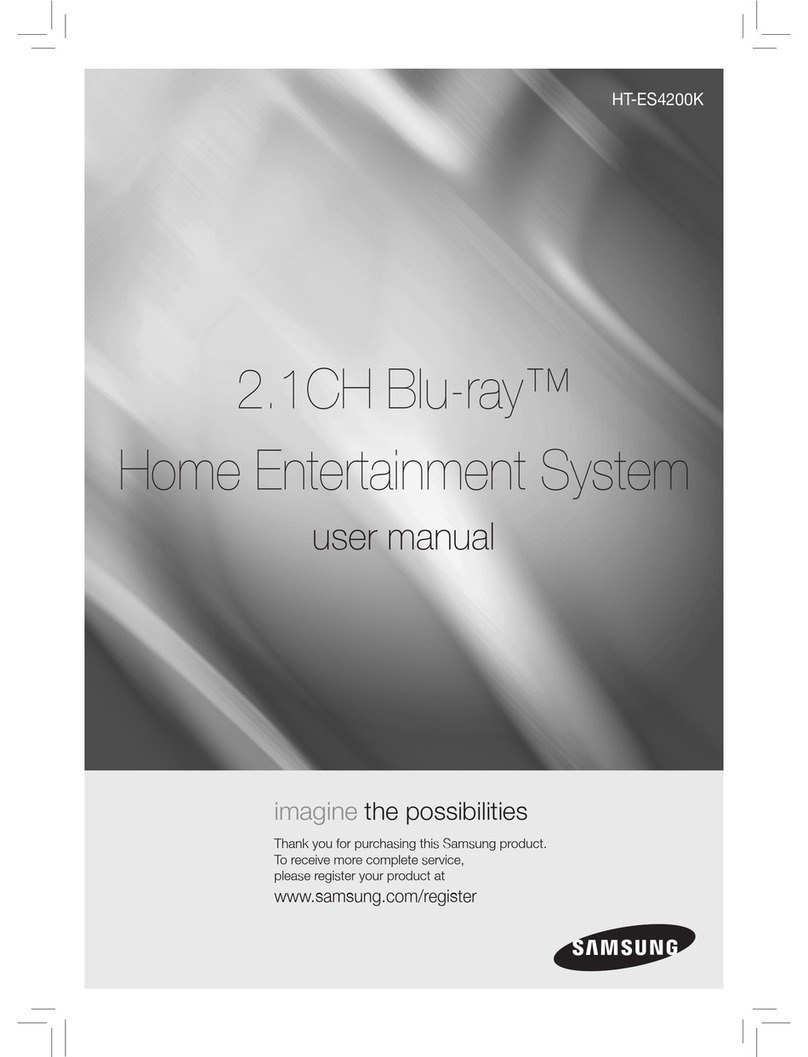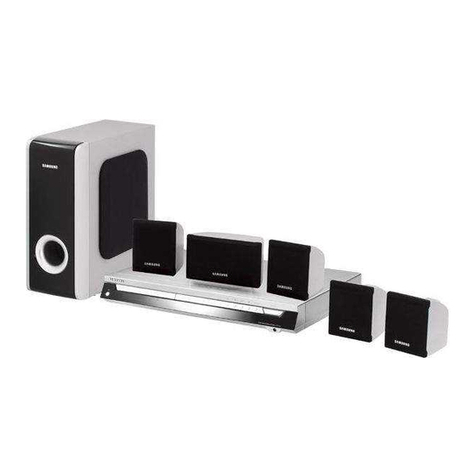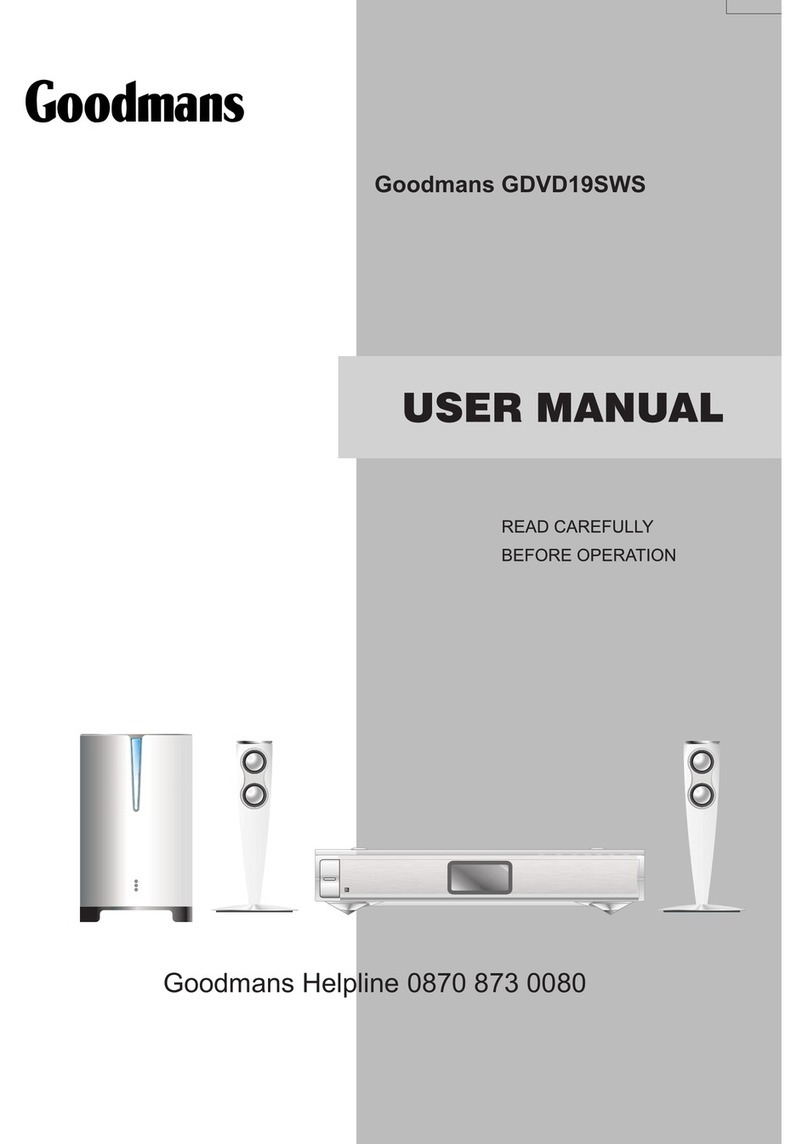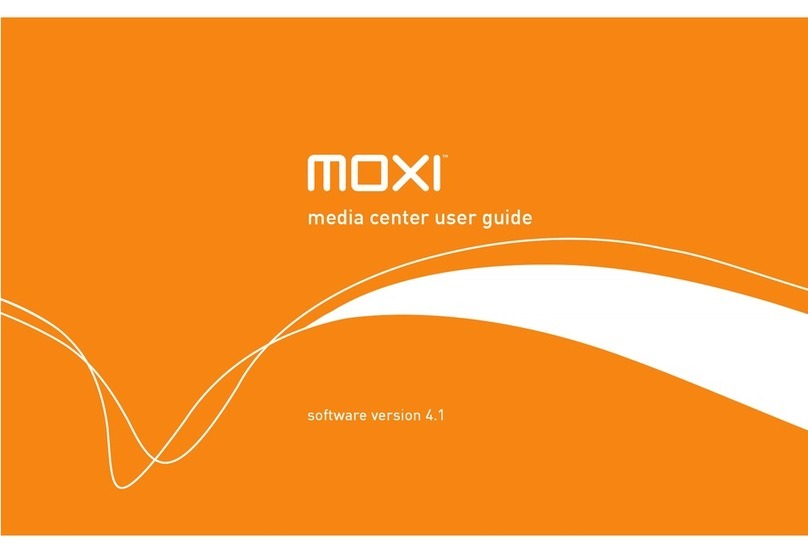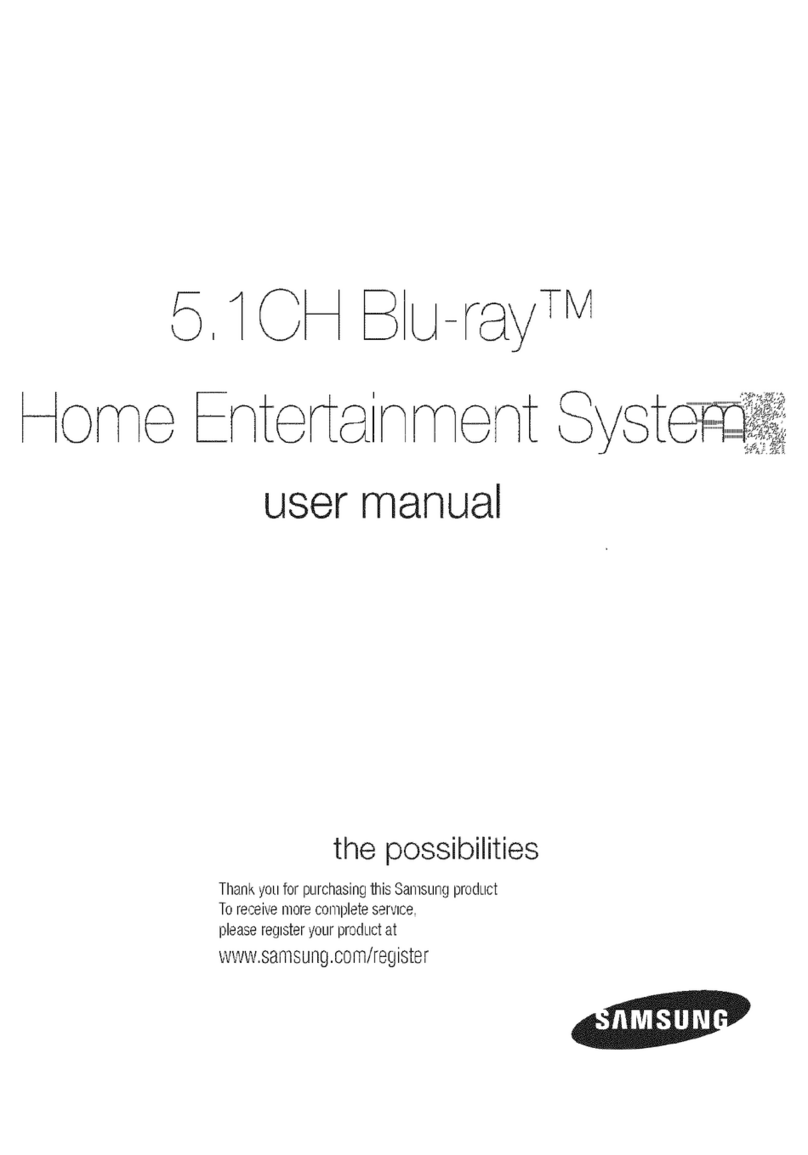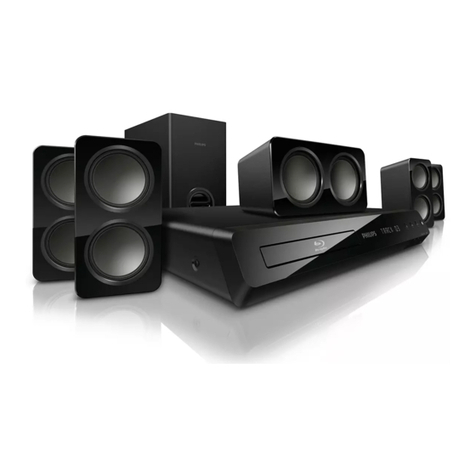Boston Acoustics Avidea 770 Safety guide

This symbol found on the apparatus indicates hazards arising from dangerous voltages.
This symbol found on the apparatus indicates the user should read all safety statements
found in the user manual.
WARNING! To reduce the risk of fire or electric shock, do not expose the apparatus to
rain or moisture.
Read these instructions.
Keep these instructions.
Heed all warnings.
Follow all instructions.
Do not use this apparatus near water.
Clean only with dry cloth.
Do not block any ventilation openings.
Install in accordance with the
manufacturer’s instructions.
Do not install near any heat sources
such as radiators, heat registers, stoves,
or other apparatus (including amplifiers) that
produce heat.
Do not defeat the safety purpose of
the polarized or grounding-type plug.
A polarized plug has two blades with one
wider than the other. A grounding type plug
has two blades and a third grounding prong.
The wide blade or the third prong are provided
for your safety. If the provided plug does not
fit into your outlet, consult an electrician for
replacement of the obsolete outlet.
Protect the power cord from being
walked on or pinched – particularly at
plugs, convenience receptacles, and the point
where they exit from the apparatus.
Only use attachments/accessories
specified by the manufacturer.
Unplug this apparatus during lightning
storms or when unused for long periods
of time.
Refer all servicing to qualified service
personnel. Servicing is required when
the apparatus has been damaged in any way,
such as if the power-supply cord or plug is
damaged, liquid has been spilled or objects
have fallen into the apparatus, the apparatus
has been exposed to rain or moisture, does
not operate normally, or has been dropped.
Maintain a minimum distance of 2 inches
(50mm) around the front, rear, and sides
of the apparatus for sufficient ventilation.The
ventilation should not be impeded by covering
the ventilation openings or placing on or
around the apparatus items such as newspapers,
tablecloths, curtains, etc.
No naked flame sources, such as
lighted candles, should be placed on
the apparatus.
The apparatus should not be exposed
to dripping or splashing. No objects
filled with liquids, such as vases, should be
placed on the apparatus.
The apparatus is suitable for use in
tropical and/or moderate climates.
LASER BEAM: Do not look into the
opening of the disc slot or ventilation
opening of the product to see the source of
the laser beam. It may cause sight damage.
DISC: Do not use a cracked, deformed,
or repaired disc.These discs are easily
broken and may cause serious personal injury
and product malfunction.
NOTE TO CATV SYSTEM INSTALLER:
This reminder is provided to call the
CATV system installer’s attention to Article
820.40 of the NEC that provides guidelines
for proper grounding and,in particular, specifies
that the cable ground shall be connected to
the grounding system of the building, as close
to the point of cable entry as practical.
...
...
SAFETY INSTRUCTIONS
3
IMPORTANT SAFETY INSTRUCTIONS 00
SECTION
SETUP AND USE GUIDE
SETUP AND USE GUIDE
AVIDEA SYSTEM
SETUP AND USE GUIDE

CAUTION:THIS DIGITAL VIDEO PLAYER EMPLOYS A LASER SYSTEM.
TO ENSURE PROPER USE OF THIS PRODUCT, PLEASE READ THIS USER’S GUIDE CAREFULLY
AND RETAIN FOR FUTURE REFERENCE. SHOULD THE UNIT REQUIRE MAINTENANCE, CONTACT
A BOSTON ACOUSTICS AUTHORIZED SERVICE CENTER.
USE OF CONTROLS,ADJUSTMENTS OR THE PERFORMANCE OF PROCEDURES OTHER THAN
THOSE SPECIFIED HEREIN MAY RESULT IN HAZARDOUS RADIATION EXPOSURE.
TO PREVENT DIRECT EXPOSURE TO LASER BEAM, DO NOT TRY TO OPEN THE ENCLOSURE.
VISIBLE LASER RADIATION MAY BE PRESENT WHEN THE ENCLOSURE IS OPENED.
DO NOT STARE INTO BEAM.
: Location of the Required Label
Complies with FDA radiation performance
standard, 21 CFR subchapter J.
Manufactured by: BOSTON ACOUSTICS INC.
300 Jubilee Drive
Peabody, MA 01960 USA
: Regulatory Compliance Statements
American Users:
This equipment has been tested and found to comply with the limits for a Class B digital device,
pursuant to part 15 of the FCC Rules.These limits are designed to provide reasonable protection
against harmful interference in a residential installation.This equipment generates, uses, and can
radiate radio frequency energy and, if not installed and used in accordance with the instructions,
may cause harmful interference to radio communications. However, there is no guarantee that
interference will not occur in a particular installation. If this equipment does cause harmful
interference to radio or television reception, which can be determined by turning the equipment
off and on, the user is encouraged to try to correct the interference by one or more of the
following measures:
Reorient or relocate the receiving antenna.
Increase the separation between the equipment and receiver.
Connect the equipment into an outlet on a circuit different from that to which
the receiver is connected.
Consult the dealer or an experienced radio/TV technician for help.
CAUTION: Unauthorized changes or modifications to the receiver not expressly approved by
Boston Acoustics could void the user’s authority to operate the equipment.
Canadian Users:
This class B digital apparatus complies with Canadian ICES-003.
Cet appareil numérique de la classe B est conforme á la norme NMB-003 du Canada.
...
...
SAFETY INSTRUCTIONS
4
INTRODUCTION 8
8 Welcome to Avidea™
9 Supplied Accessories
10 Optional Accessories
INSTALLATION 11
11 Avidea System Setup
11 The Avidea Control Center
11 The Avidea Subwoofer
11 The Avidea Speakers
12 Connecting Basic System Components
12 Inputs and Outputs and the Rear Panel
13 The Avidea Control Center to the Avidea Subwoofer
13 The Avidea Speakers to the Avidea Subwoofer
14 Connecting the RF Receiver/Antenna
14 Connecting AM and FM Antennas
15 Connecting Other Devices
15 About Connections
16 Connecting Devices
16 Connecting a Television
18 Connecting a Cable Box or Satellite Receiver
20 Connecting Other Audio or Audio/Video Devices
OPERATION 24
24 Introduction to the Avidea Control Center
24 The Avidea Display
25 Control Buttons
27 Introduction to the Avidea RF Universal Remote
27 The Avidea Remote Control Layout
28 Turning On the Avidea System
28 Playing a Disc (DVD or CD)
29 Controlling a Disc Using the Avidea Remote Control
32 Controlling a Disc From the Avidea Control Center
...
...
TABLE OF CONTENTS
5
02
SECTION
01
SECTION
03
SECTION
Location of the Required Label
TABLE OF CONTENTS 00
SECTION
00
SECTION IMPORTANT SAFETY INSTRUCTIONS

TROUBLESHOOTING 59
SPECIFICATIONS 63
SPEAKER MOUNTING TEMPLATES 65
...
...
TABLE OF CONTENTS
7
33 Operating the AM/FM Tuner
33 Controlling the AM/FM Tuner Using the Avidea Remote Control
35 Controlling the AM/FM Tuner From the Avidea Control Center
36 Selecting Other Devices
36 Listening Modes
36 Introduction to Listening Modes
37 Sleep Mode
ADVANCED OPERATION 38
38 Use of the On-Screen Displays (OSD)
38 The Status Bar
40 The Setup Menu
44 Using the Setup Menu Features
44 DVD Parental Control
44 Setting Speaker Levels
45 Center and Rear Speaker Delay Adjustments
45 Component Video Assignment
46 External Source Level Adjustment
46 Audio Signal Path Assignment
46 Video Black Level Adjustment
47 MP3 Disc Navigation
47 Customizing Speaker Connections
48 Changing the RF/IR Settings
48 Changing Infrared (IR) Components to Radio Frequency (RF) Control
50 Changing Avidea Control Center RF Settings
51 Changing Avidea Remote Control RF Settings
52 Changing System Remote Control Operation to IR
55 Zone 2 Installation and Operation
REFERENCE 57
57 Cleaning the Avidea Control Center and Avidea Speakers
57 Cleaning the Avidea Remote Control
57 Replacing the Avidea Remote Control’s Batteries
57 Glossary of Terms
...
...
TABLE OF CONTENTS
6
04
SECTION
05
SECTION
06
SECTION
07
SECTION
08
SECTION
TABLE OF CONTENTS 00
SECTION
00
SECTION TABLE OF CONTENTS

SUPPLIED ACCESSORIES
In addition to the main components, you will find the following supplied accessories for your
Avidea system.
...
...
INTRODUCTION
9
WELCOME TO AVIDEA™
Congratulations on your purchase of the Avidea Home Entertainment
System.Your new system incorporates several innovative technologies
designed to deliver a powerful entertainment experience from an
elegant and easy-to-use system.
Please save this Guide for future reference. If you should need an additional
copy, it may be downloaded from the Boston Acoustics website:
www.bostonacoustics.com/avidea.
With your Avidea system, you can enjoy virtually all entertainment sources currently available,
reproduced with the latest generation of multi-channel surround sound formats, and all controlled
by an advanced universal Remote Control. Here is an overview of your Avidea system’s features:
• Elegant, easy-to-use Control Center with slot-loading, progressive scan DVD player. Plays
standard 43/4-inch (12cm) size of the following discs: DVD-Video, DVD-Audio, DVD±RW/±R,
CD, CD-R, CD-R/W, and MP3 CD
• Dolby Digital®EX, DTS®ES, Dolby Pro Logic®II, and Neo:6
• High performance AM/FM Tuner with 27 presets in three banks of nine
• Inputs for up to six additional sources. Includes analog and digital audio inputs, as well as a
convenient forward mounted set of inputs that allow quick connection of video game consoles
and camcorders
• Universal touchscreen LCD Remote Control uses radio frequencies as well as standard infrared
to operate your system and other components from virtually anywhere in your home. Learns
codes for operating other sources and can be customized with included CD-ROM
• Powered Subwoofer contains a front-firing DCD™driver and amplification for seven
channels
• Six elegant, compact extruded aluminum speakers feature dual woofer, two-way design and
integrated wall mounts
• Active equalization and custom crossovers ensure accurate acoustic reproduction
• Easy-to-use, color-coded speaker connectors for quick and correct system setup
• Zone 2 audio output that allows independent listening in another part of your home
• UniView™video signal management system ensures that all connected video components
operate at maximum performance levels
• Listening Mode Memory™automatically recalls your source listening preferences
• Powerful On-Screen Display provides total control over your system
• Optional UMB1 adjustable wall-mount brackets and A7fs floor stands
...
...
INTRODUCTION
8
Speaker Cables : 3 x 16 feet (5m),
3 x 49 feet (15m)
To connect the Avidea Speakers to the Avidea
Subwoofer. A total of six speaker cables are
packed with your system. Each has a color-
coded connector on both ends to match a
speaker. Rear channel speaker cables are
longer to allow for the greater distances
between rear speakers and the Subwoofer.
Subwoofer Cable : 16 feet (5m)
A special multi-pin cable which is used to
connect the Avidea Subwoofer to the Avidea
Control Center.
Subwoofer AC Cord
Connects to the rear panel of the Avidea
Subwoofer.
RF Receiver/Antenna
Provides signal to the Avidea Control Center
from the Avidea Remote Control. It is connected
to the RF Antenna jack on the rear panel of
the Control Center.
AM and FM Antennas
Provides signal to the Avidea AM/FM Tuner.
Avidea Remote Control
Operates the Avidea system and all connected
Devices.
Avidea Remote Control Setup and Use Guide
Provides instruction on the use of the Avidea
Remote Control.
Three AA Batteries
For installation in the Remote Control.
(See separate Avidea Remote Control Setup
and Use Guide for further instructions.)
Serial Cable
Used only when customizing your Avidea
Remote Control from your PC. (See separate
Avidea Remote Control Setup and Use Guide
for further instructions.)
FreedomEdit CD-ROM
Used to customize the Avidea Remote
Control. (See separate Avidea Remote Control
Setup and Use Guide for further instructions.)
INTRODUCTION 01
SECTION
01
SECTION INTRODUCTION

AVIDEA SYSTEM SETUP
: The Avidea Control Center
Placement of the Avidea Control Center is a matter of convenience.Things to keep in mind
include the distance from the Avidea Subwoofer (it will be connected to the subwoofer with
a supplied 16 foot (5m) cable; an optional A7lc 66 foot (20m) cable is available), and proximity
to an electrical outlet.
xNote : Please do not plug the Control Center into an electrical outlet until all other connections are made.
: The Avidea Subwoofer
Place the Avidea Subwoofer close enough to the Control Center to allow the supplied subwoofer
cable to reach it. Also, the subwoofer needs to be close to an electrical outlet. Increased bass
performance can be achieved by moving the subwoofer closer to a corner. Ensure that you allow
an adequate distance between the rear of the subwoofer and the wall and other objects for proper
heat dissipation.The subwoofer is not magnetically shielded and should be kept at least 18 inches
(50cm) away from most televisions to avoid interference with the video image.
xNote : Please do not plug the subwoofer into an electrical outlet until all other connections are made.
: The Avidea Speakers
The Avidea Speakers can be placed on existing shelving or furniture with the application of the
supplied rubber feet to the bottom of the speaker. The speakers can also be wall mounted using
screws and the keyhole mounts on the speaker’s rear panel. Mounting templates are provided at
the back of this guide to assist you in wall mounting the speakers.
xNote : Please consult a qualified installer to assure use of the proper fasteners for your wall surface.
The optional UMB1 wall-mount brackets provide tilt and swivel capability, while the optional A7fs
floor stands place the speaker at the proper listening height in rooms where wall mounting or
shelf placement is not convenient.
...
...
INSTALLATION
11
S-Video Cable : 6.5 feet (2m)
Used to connect the Avidea Control Center to
the S-Video input/output of a television or
other video component.
Composite Video Cable : 5.25 feet (1.6m)
Used to connect the Avidea Control Center to
the Composite Video input/output of a televi-
sion or other video component.
Audio Cable : 5.25 feet (1.6m)
Used to connect the Avidea Control Center to
the stereo input/output of an audio or video
component.
Center Channel Speaker Posts
Two “threaded posts” are supplied to allow
the center channel speaker to sit properly on
a flat surface or when placed on top of some
televisions with shallow tops. Depending on
the television, you may need to use the short
or long post to provide support for the rear
of the speaker onto the back of the television.
The short post comes pre-installed, and can be
slightly extended to keep the speaker from
rocking backwards when it is placed on a
flat surface.
IR Emitter : 6.5 feet (2m)
Provides IR signal to conventional IR
components when using RF to control them.
Rubber Feet
The self-adhesive feet may be used on the
bottom of the Avidea Speakers to help protect
your furniture. They can also help minimize
the speakers’ movement when the system is
played at high volumes. Place one foot at
each corner at the front bottom edge of the
center channel speaker. Use one foot at each
of the four corners on the bottom of the
other speakers.
...
...
INTRODUCTION
10
OPTIONAL ACCESSORIES
The A7fs floor stand and UMB1 wall bracket are available to allow you to place the speakers
around the room in a manner that is convenient and aesthetically pleasing. See your Boston Acoustics
dealer for additional information.
Additional Avidea Remote Controls (A7rc) are available and are particularly useful when establishing
a second Zone outside your main listening area. (See ‘Zone 2 Installation and Operation’ on page 55.)
A 66 foot (20m) CL2-rated Subwoofer cable (A7lc) is available for installations that require long
cable runs between the Avidea Control Center and the Avidea Subwoofer. A CL2 rating is required
when the cable is installed in walls, floors, and ceilings.
INSTALLATION 02
SECTION
01
SECTION INTRODUCTION

: The Avidea Control Center to the Avidea Subwoofer
Connect one end of the Avidea Subwoofer cable to Connect to Subwoofer/Audio Out on the
Control Center’s rear panel. Plug the other end of the cable into To Control Center located on
the rear of the subwoofer. Make sure that the clamps on the side of the plugs snap into place to
secure the connections.
: The Avidea Speakers to the Avidea Subwoofer
All speaker connections are made to the rear panel of the subwoofer using the supplied cables.
Cables for the front speakers are 16 feet (5m) while the rear speaker cables are 49 feet (15m),
since rear speakers are typically farther away from the subwoofer.
Connect the Avidea Speakers by matching the color-coded speaker connector to the same color-
coded receptacle on the rear of the subwoofer and to each individual speaker.
The color-coding is as follows:
xNote : The speaker cables are supplied with a unique connector at each end. To shorten the supplied speaker cables
or replace them with longer wires, see ‘Customizing Speaker Connections’ on page 47.
...
...
INSTALLATION
13
The front left and right speakers should be placed on either side of your television.The center
channel speaker should be placed above, on top of, or below your television. Exact placement of
the front three speakers may be determined by what is most visually pleasing, although the best
sound usually is attainable when the left and right speakers are at least six feet apart.The best
location for your rear speakers is dependent on your room and your primary listening position.
If the primary listening position is closer to the middle of the room, then better results may be
obtained by placing the left and right rear speakers on the side walls (see ‘Figure A’ below). If the
primary listening position is closer to the rear of the room, then better results may be obtained
by placing all three rear speakers on the rear wall (see ‘Figure B’ below).
xNote : Please experiment with placement before attaching the speakers to the wall.
CONNECTING BASIC SYSTEM COMPONENTS
: Inputs and Outputs and the Rear Panel
A total of six different Devices can be connected to the Avidea Control Center using the inputs
on the side and rear panel. The Front inputs (located on the right/front side) are convenient
when making connections to game consoles or camcorders.
Please do not plug the subwoofer or Control Center into an electrical outlet until all
other connections are made.
...
...
INSTALLATION
12
Subwoofer
Control Center
Subwoofer
Control Center
Figure A : Side wall and rear wall Figure B : Rear wall only
• Front Right [ FR ] : Red
• Front Center [ FC ] : Green
• Front Left [ FL ] :White
• Rear Right [ RR ] : Grey
• Rear Center [ RC ] : Brown
• Rear Left [ RL ] : Blue
INSTALLATION 02
SECTION
02
SECTION INSTALLATION

15
...
...
The speakers include keyholes on the rear panel for convenient wall mounting with screws. Once
mounted, wire may pass out either end of the speaker. There is also a small notch in the middle of
the bottom edge of the center channel speaker to allow its speaker wire to exit at that point
rather than at the end.
xNotes : Templates to assist you in wall mounting the speakers can be found on the last page of this Guide.
Connecting additional speakers to your Avidea system requires the use of the Zone 2 audio outputs and an
additional amplifier. (See ‘Zone 2 Installation and Operation’ on page 55.)
: Connecting the RF Receiver/Antenna
The supplied RF Receiver/Antenna must be plugged into the Avidea Control Center to
allow the Avidea Remote Control to operate the Avidea Control Center.
The Avidea Remote Control communicates with your Avidea system via Radio Frequencies (RF).
This feature allows you to control the system even when it is in a closed cabinet or from another
room. Plug the Receiver/Antenna into RF Antenna In located on the right side of the rear panel
of the Control Center.The RF Receiver/Antenna should be placed as far away as possible from the
Control Center and other metal objects to maximize the operating range and the effectiveness of
the Remote Control. Maximum Remote Control range is approximately 66 feet (20m), although
local interference and building construction materials can reduce this distance.The RF Receiver/Antenna
may be laid on its back or side on any flat surface.To attach the RF Receiver/Antenna to a vertical
surface, you may mount it using its integrated keyhole. As an option, any of a variety of self-adhesive
wall mounting products may be used.
: Connecting AM and FM Antennas
...
...
INSTALLATION
14
Connections for both antennas are located on the far left section of the Avidea Control Center’s
rear panel. Attach the two bare wire ends of the AM antenna to the two spring-loaded AM connectors.
Press the lever to open the hole, and release the lever once the wire is inserted. Position the AM
antenna as far from the Avidea Control Center as the antenna wires allow (at least 18 inches).You
should experiment with the antenna’s orientation in order to optimize your AM reception.
Different AM stations may require re-orienting the AM antenna.
Plug the FM antenna into FM 75 Ωand uncoil the antenna.You should experiment with the antenna’s
orientation in order to optimize your FM reception.
xNote : It is possible to improve radio reception with the use of accessory antennas. Please consult your Boston
Acoustics dealer.
CONNECTING OTHER DEVICES
: About Connections
When connecting video Devices (cable boxes, satellite receivers,VCRs, etc.), separate cables are
required for the picture (video) and the sound (audio). Avidea offers a choice of connections for
each component. Select the highest performance connections available from your Devices as
explained below.
Audio Inputs and Outputs can be either digital or analog, with digital being the higher quality.
In most cases, match color-coded outputs on your Device to inputs on your Avidea system.
Video Connections
• Best Picture : Component Video connections provide the highest resolution available, using
three separate cables color-coded Green (Y), Blue (Pb), and Red (Pr).Typically, only high defini-
tion and digital sources offer Component video connections.
• Excellent Picture : S-Video connectors have several small pins located within an outer ring.
They are “keyed” so that they can only be inserted when all the pins line up correctly.
• Standard Picture : Standard Composite video should only be used when neither of the
above connections is available. It is usually color-coded Yellow.
INSTALLATION
INSTALLATION 02
SECTION
02
SECTION INSTALLATION

Audio Connections
• Digital : A Digital Coaxial cable, usually color-coded Orange, or a Fiber Optic Toslink cable
provides the highest quality sound.
xNote : Use only one Digital connection per Device. Use coaxial if both coaxial and optical are available.
• Analog : Standard audio connectors provide high quality analog audio. Although the left
connector is usually color-coded White, it sometimes may be Black or Grey.
: Connecting Devices
To connect Devices, match outputs to inputs. In most cases, match similar, color-coded jacks with
the appropriate cable. Here is a list of the most commonly connected Devices, as well as the
different methods of connecting them.
xNote : Each Device connection diagram may show more than one connection method, as it is not known what
type of inputs and outputs are available on your Devices. Your Devices may have better connection capability, for
example S-Video is better than composite, or digital audio is better than analog. Always attempt to use the highest
quality connection available. (See ‘About Connections’ on page 15 for more information.)
: Connecting a Television
Connecting a Digital TV
High Definition and Digital TVs provide Component Video Inputs.To take full advantage of this
type of equipment, Component Video Connections should be used. Connect a Component Video
cable (not supplied) from Monitor Out (To TV) Component on the rear panel of the Control
Center to a Component Video Input on your TV.
Your Avidea system is equipped with a progressive scan DVD player. To avoid potential incompatibility
problems,Avidea is set to the interlace or INT mode. If you are connecting to a digital television
you must move this switch to the PROG setting to gain maximum performance.When the Avidea
Control Center is switched to progressive scan mode, there is no output from the Composite or
S Monitor Out (To TV).
xNote : The Avidea Remote Control must be programmed to operate your television. (See ‘Entering Codes for Other
Devices’ on page 21 of the Avidea Remote Control Setup and Use Guide.)
xImportant Note : There are two sets of Component Video connectors on the rear panel of the Avidea Control Center.
Make sure that you connect your TV’s Component Video Inputs to Monitor Out (To TV) Component and NOT to
the Component Video In. Component Video Cables are color-coded: Green (Y), Red (Pr), and Blue (Pb). Make sure
to match the connectors to the same colored jacks.
Connecting a Standard TV with S-Video
Connect the S-Video cable from Monitor Out (To TV) S on the rear panel of the Control Center
to an S-Video Input on your TV.
xNote : The Avidea Remote Control must be programmed to operate your television. (See ‘Entering Codes for Other
Devices’ on page 21 of the Avidea Remote Control Setup and Use Guide.)
Connecting a Standard TV with Composite Video
Connect the Composite Video cable from Monitor Out (To TV) Composite on the rear panel of
the Control Center to a Composite Video Input on your TV.
xNote : The Avidea Remote Control must be programmed to operate your television. (See ‘Entering Codes for Other
Devices’ on page 21 of the Avidea Remote Control Setup and Use Guide.)
...
...
17
...
...
INSTALLATION
16
INT/PROG switch
Switch to PROG
INSTALLATION
INSTALLATION 02
SECTION
02
SECTION INSTALLATION

...
...
19
: Connecting a Cable Box or Satellite Receiver
Connecting a High Definition (HD) Cable Box, HD Satellite Receiver, or
HD Terrestrial Receiver
HD Cable Boxes and Receivers provide Component Video Outputs.To take full advantage of this
type of equipment, Component Video Connections should be used.
Connect a Component Video cable (not supplied) from the Cable Box or Receiver Video out to
Component Video In on the rear panel of the Control Center. Connect a Digital Audio cable
(not supplied) from the Cable Box or Receiver Digital Audio Output to Cable/Sat Digital Audio.
xImportant Note : You must assign the Component Video Inputs to the Cable/Sat Device. (See ‘Component Video
Assignment’ on page 45.)
xNotes : The Avidea Remote Control must be programmed to operate your Cable Box or Satellite Receiver.
(See ‘Entering Codes for Other Devices’ on page 21 of the Avidea Remote Control Setup and Use Guide.)
It is possible to connect both a Digital Cable Box and a Satellite Receiver to the Avidea Control Center. Connect either
Device to the Cable/Sat input, and then use another, unused audio/video input (Changer, VCR, or TV) for the other
Device. You can relabel that other Device on the Avidea Remote Control. Use FreedomEdit and your PC to change the
Device associated with the other input. (See the FreedomEdit CD-ROM that came with your Avidea Remote Control.)
...
...
INSTALLATION
18
Connecting a Digital Cable Box or Satellite Receiver
Connect a Digital Audio cable (not supplied) from the Digital Audio Out on the Cable Box or
Satellite Receiver to the Cable/Sat Digital Audio on the rear panel of the Control Center.
Connect the S-Video Output from the Digital Cable Box or Satellite Receiver to the Cable/Sat S
Input on the rear panel of the Control Center. If a Digital Audio Output and/or S-Video Output
are not available on your Digital Cable Box, you may use Analog Audio and/or Composite Video.
xNote : The Avidea Remote Control must be programmed to operate your Cable Box or Satellite Receiver.
(See ‘Entering Codes for Other Devices’ on page 21 of the Avidea Remote Control Setup and Use Guide.)
Connecting Audio from a TV Using a Standard Cable Box
Connect the cable wire from your cable company to the Cable Input on the cable box. Connect
the To TV Output from the cable box to the ANT Input on your TV. Connect the Audio Output from
your TV to Cable/Sat Audio on the rear panel of the Control Center.You may wish to permanently
shut off the TV’s internal speakers and set the TV’s audio output to “fixed” if that option is available.
Please consult your TV owner’s manual.
xNotes : The Avidea Remote Control must be programmed to operate your Cable Box. (See ‘Entering Codes for Other
Devices’ on page 21 of the Avidea Remote Control Setup and Use Guide.) Select Cable/Sat on your Avidea Remote
Control to operate your cable box.
This configuration will not allow use of the Avidea Status Bar or Setup Menu while watching TV.
INSTALLATION
INSTALLATION 02
SECTION
02
SECTION INSTALLATION

Connecting Audio from a TV Using an Antenna or Cable Without a Cable Box
If you are using the Tuner in your TV to watch cable or regular off-air programming, you will need
to supply the audio signal to the Avidea system. Connect your TV’s Audio Out to the TV (From
TV) Audio on the rear panel of the Control Center.You may wish to permanently shut off the TV’s
internal speakers and set the TV’s audio output to “fixed” if that option is available. Please consult
your TV owner’s manual.
xNotes : The Avidea Remote Control must be programmed to operate your TV. (See ‘Entering Codes for Other Devices’
on page 21 of the Avidea Remote Control Setup and Use Guide.)
This configuration will not allow use of the Avidea Status Bar or Setup Menu while watching TV.
: Connecting Other Audio or Audio/Video Devices
Connecting a VCR or PVR (Personal Video Recorder)
Connect the Audio and Video Outputs on your VCR or PVR to the VCR/PVR Audio In and Video
In on the rear panel of the Control Center. Connect the Audio and Video Inputs on your VCR or
PVR to the VCR/PVR Audio Out and Video Out on the rear panel of the Control Center. Owners
of certain PVRs used in conjunction with a satellite receiver or digital cable box may want to
connect the two Devices directly to each other for recording. Please consult your PVR owner’s
manual for details.
You must set the Avidea Control Center to Stereo or 5 speaker mode when recording to a VCR or
PVR from other Devices connected to the Avidea system. (See ‘Listening Modes’ on page 36.) To
record from any Device to a VCR or PVR, that Device must be connected by an analog audio cable.
Connecting a Cassette Deck
Connect the Audio Outputs (Play) on your Cassette Deck to the Aux Audio In on the rear panel
of the Control Center. Connect the Audio Inputs (Rec) on your Cassette Deck to the Aux Audio
Out on the rear panel of the Control Center.
You must set the Avidea Control Center to Stereo or 5 speaker mode when recording to a Cassette
Deck from other Devices connected to the Avidea system. (See ‘Listening Modes’ on page 36.) To
record from any Device to a Cassette Deck, that Device must be connected by an analog audio cable.
Connecting a MiniDisc or CD Recorder
MiniDisc (MD) and CD Recorders offer digital connections. Use the appropriate connectors
(not supplied) to connect the Audio Outputs (Play) from your MiniDisc or CD recorder to the
Aux Audio In on the rear panel of the Control Center. Connect the Audio Inputs (Rec) from
your MiniDisc or CD recorder to the Aux Audio Out on the rear panel of the Control Center.
You must set the Avidea Control Center to Stereo or 5 speaker mode when recording to an MD/CD
Recorder from other Devices connected to the Avidea system. (See ‘Listening Modes’ on page 36.)
To record from any Device to an MD/CD Recorder, that Device must be connected by a digital
audio cable (not supplied). If a digital output is not available for a Device from which you wish to
record, then use an analog audio cable and connect your MD/CD recorder with an analog cable in
addition to a digital cable. Consult your MD/CD Recorder owner’s manual to record from an analog
signal.
21
...
...
...
...
INSTALLATION
20
Audio
Video Video Video In
OutAudio OutDigitalAnalog
+12V
YY
IR 1
In
Antenna
IR 2
Ch
ID
Prog.
Int.
Connect To Subwoofer
Pr Pr
Pb Pb
SCompositeComposite ComponentS
L
R
L
R
TV (From TV) Component RF
Audio Out Remote
Monitor Out (To TV)
Zone 2 Trigger
UL
7H57
®
WARNING
AVIS
770
DVD Control Center
Rating : AC 120V 80Hz 50W
Boston Acoustics, Inc.
Peabldy,MA USA
Designed in USA / Made in China
RISQUE DE CHOC ELECTRIQUE
NE PAS OUVRIR
C US
LISTED
AUDIO/VIDEO
EQUIPMENT
E206909
RISK OF ELECTRIC SHOCK
DO NOT OPEN
INSTALLATION
INSTALLATION 02
SECTION
02
SECTION INSTALLATION

Connecting a Forward-Mount Game or Camcorder
The set of inputs mounted on the right side of the Control Center allow you to connect and
disconnect components without having to move the Control Center to access the rear panel.
Devices that may be connected on a temporary basis include camcorders and video games.
These devices usually include special cables that supply audio and video outputs.You may want
to refer to your camcorder or video game manual for more information on connecting them to
other components.
Connecting Headphones
The headphone jack is located on the right side of the Avidea Control Center. Inserting
a headphone jack will mute all the Avidea system’s speakers.
xNote : The headphone jack is 1/8 inch (3.5mm), standard for most headphones. An optional adapter
(not included) will enable you to connect other size plugs, and is available at your Boston Acoustics dealer.
...
...
23
Connecting a CD Changer
Connect the Audio Outputs from your CD Changer to the Changer Audio Inputs on the rear
panel of the Control Center. Some CD Changers have digital as well as analog outputs.You may
choose to use either one.
Connecting a DVD Changer
Connect the Digital Audio Output from your DVD Changer to the Changer Audio Input on the
rear panel of the Control Center. Connect the Video Out on your DVD Changer to the Changer
Video Input. If your DVD Changer is progressive scan, connect its Component Video Outputs to
Component Video In, unless it is already being used by your HD Cable Box, Satellite Receiver,
or Terrestrial Receiver. If that is the case, use S-Video instead.
xNote : The library of Device codes associated with the Changer are for CD players and CD Recorders. Any given
brand of DVD player or recorder may use the same codes. If that is not the case for your Device, then you may use
Learning Mode to teach all the appropriate commands from the original Remote Control to the Avidea Remote
Control. You may also choose to use FreedomEdit and your PC to change the Device associated with the Changer
input. (See the FreedomEdit CD-ROM that came with your Avidea Remote Control.)
...
...
INSTALLATION
22
INSTALLATION
INSTALLATION 02
SECTION
02
SECTION INSTALLATION

: Control Buttons
The buttons on the Avidea Control Center provide a simple level of control over the Avidea system.
System level controls (Power, Source,Volume +, Volume -) are always active and always have the
same function. and change function depending on the Device, and have no function when
the Device is external to the Control Center.The eject button is next to the disc slot for removing
a disc from the system.
...
...
OPERATION
25
INTRODUCTION TO THE AVIDEA CONTROL CENTER
The Avidea Control Center is the heart of your system. It contains a DVD/CD player, AM/FM
Tuner, video/audio inputs and outputs plus all the circuitry needed to control your entire home
entertainment system. The Control Center can be operated directly by use of the controls on
the unit or with the supplied Avidea Remote Control.
On the front of the Control Center is the disc player slot and the disc eject button.The system
display area is surrounded by six small, blue speaker indicator lights that show how many
speakers are playing.
: The Avidea Display
• Typically, the display shows the current Device, the play mode, current track/chapter/preset,
and elapsed time or Tuner setting.The specific information displayed differs for each Device.
The display also indicates, if Zone 2, Night, or Sleep modes are active. (See ‘Zone 2 Installation
and Operation’ on page 55 and ‘Sleep Mode’ on page 37 for more information on these opera-
tions.)
• If you are changing the Device, volume, or other state of the Device, via either the Control
Center controls or Remote Control, that information is also briefly displayed in a larger size.
xNote : The information on the Control Center’s display is also communicated via the On-Screen Display Status
Bar. (See ‘Use of the On-Screen Displays (OSD)’ on page 38.)
Display Brightness
When a button is pressed on the Control Center or a command is sent to the Control Center
from the Remote Control, the display brightens to maximum brightness.The display remains
bright for five seconds after the last button is released.
The Avidea Speaker Indicator Lights
Surrounding the display area are six small blue lights, representing the position of each speaker
in the room.The lights that are on correspond to those speakers that are playing.
xNote : The Avidea Subwoofer is always on when the Avidea system is on.
...
...
OPERATION
24
Device Playing Chapter, Track,
Station, or Folder
Playing
Play Mode Time Into Selection
Disc Indicator
Repeat Function
ON/OFF
Zone 2 ON
and Device Sleep Timer
ON + Time Random Function
ON/OFF
Night Mode ON
6 Lights : 6 Speakers Playing
5 Lights : 5 Speakers Playing
2 Lights : 2 Speakers Playing
Power Source Volume
OPERATION 03
SECTION
03
SECTION OPERATION

CONTROL BUTTON WHAT IT DOES
Turns the Avidea system on or off.
Selects the next source (Device) and puts the display into “source mode.”
This button only responds to a single press, and does not repeat if held.
When using Disc, press to go to the beginning of the current chapter/track,
if current chapter/track playing time is more than five seconds.
Goes to the previous chapter/track, if current chapter/track playing
time is less than five seconds.
Press again to go to the beginning of the previous chapter/track.
Press-and-hold to play in reverse at 4x normal speed.
When using Tuner, selects the next Tuner preset down from the last preset
chosen. Starts from preset A1 if preset tuning has not been previously
used.This will occur even if there are no stations stored in any preset.
When using Disc, press to go to the beginning of the next chapter/track.
Press again to go to the beginning of the next chapter/track.
Press-and-hold to play forward at 4x normal speed.
When using Tuner, this works like the control, but in the
forward direction.
Stops a disc. For a DVD, a single press will stop the Disc, but DVD will
resume play at the same point. Press stop twice to return to the main
DVD menu.
If a disc is playing, this will put the disc into pause. If the disc is already
paused, pressing the button will resume playing the disc.
Turns the volume down one level with each press. Press-and-hold to
turn the volume down continually and rapidly.
Turns the volume up one level with each press. Press-and-hold to turn
the volume up continually and rapidly.
Power
Source
(Disc)
(Tuner)
(Disc)
(Tuner)
(CD/DVD)
(CD/DVD)
Volume
Volume
INTRODUCTION TO THE AVIDEA RF UNIVERSAL REMOTE
xNote : The full setup and use of the Avidea Remote Control is covered in the separately supplied Guide.
The Avidea Remote Control communicates to the Avidea Control Center using Radio Frequencies
(RF) and not conventional Infrared (IR). Unlike IR, RF signals penetrate walls, ceilings, and cabinetry.
This means that you can control your system without pointing the Remote Control at the system,
if it is hidden away in a closed cabinet, or even from another room.This functionality provides a
level of convenience and flexibility not available from conventional remotes.The Remote Control
has a maximum range of approximately 66 feet (20m).
The Avidea Remote Control is designed to control everything connected to your Avidea system.
This is accomplished by utilizing the built-in library of codes for other manufacturers’ remotes, or
through the Avidea Remote Control’s learning capability. Additionally, the Avidea Remote Control
can be customized using the supplied FreedomEdit software.
The Avidea Remote Control requires three AA batteries (3 x 1.5 volts) to function.You can use
either the supplied batteries or purchase rechargeable batteries.
: The Avidea Remote Control Layout
The Avidea Remote Control has “hard” buttons and touchscreen “soft” buttons.Touchscreen buttons
are simulated buttons you can press on the LCD touchscreen. Hard buttons are all the other buttons
on the Avidea Remote Control.
...
...
27
...
...
OPERATION
26
Avidea System Power
TV Power
Serial Port for connecting to a PC
Backlight Button
Page Up Button
Page Down Button
LCD Touchscreen
Soft Buttons
OSD Button (Opens Avidea On-Screen Display)
Close Button (Closes Avidea On-Screen Display)
Device Button (Displays Device selection page)
Mode Button
(Press-and-hold for three seconds to switch
Remote Control to another mode)
Avidea System Volume Up/Down
Navigation Buttons
Avidea System Mute
Channel Up/Down
TV Source (TV input selector)
Learning Eye
OPERATION
OPERATION 03
SECTION
03
SECTION OPERATION
xNote : The first time you turn on your Avidea system it will play at a volume setting of "70" (volume range is 0 to 100).
With any future use, Avidea will turn on at "70" if last used at that volume or higher. This is to prevent accidentally
turning on the system at an excessive volume. If last used at a volume less than "70", Avidea will turn on at that volume.

Press Play on the Avidea Remote Control to start a CD playing. A DVD will play until it reaches
its menu. Use the Remote Control Navigation buttons to move within the DVD menu and make
selections.When inserting any type of disc, the system must be on and Disc must be the
selected Device.
xNotes : The Control Center will not accept a disc if there is a disc already in the unit.
Your Avidea system plays Region 1 DVDs. To ensure compatibility, only purchase discs that show the Region 1
designation on the disc label or packaging.
: Controlling a Disc Using the Avidea Remote Control
There are six LCD pages for controlling the Avidea Disc Player. Selecting Disc from the Devices
page will turn on the Avidea system if it is off, switch the source to Disc, and switch the Remote
Control to Disc page one.
Disc Control
The first LCD page provides touchscreen button control of basic disc functions.
Each press of Fast Forward or Fast Reverse will increase speed of forward/reverse play as follows:
xNote : The Navigation buttons on the Remote Control are used to move within menus. Additionally, the Channel -/+
hard buttons function as skip forward/backward touchscreen buttons.
...
...
29
...
...
OPERATION
28
Exits selected DVD menu
Goes to individual DVD title
menu (if available)
Increases play speed in
forward direction
(See table below)
Goes to the beginning of the
next chapter/track
Goes back one step within a
currently selected DVD menu
Goes to the DVD’s main
menu of selections
Increases play speed in
reverse direction
(See table below)
Goes to the beginning of the
current or previous
chapter/track
Pauses disc
First press f 2x speed
Second press f 4x speed
Third press f 8x speed
Fourth press f 16x speed
Fifth press f 30x speed
Sixth press f 60x speed
Stops disc Plays disc
Device
Button
Navigation
Button: Right
Navigation
Button: Up
Navigation
Button: Left
Navigation Button: Down
Navigation Button: OK
(Acts as “Enter” for some Devices)
Turns Avidea
system ON and
selects Disc
as Device
Using the Touchscreen Buttons
You operate the touchscreen buttons in the same way you operate hard buttons on a conventional
remote control.When you keep the touchscreen button pressed, the Avidea Remote Control keeps
sending the command for up to 30 seconds. Once you have selected a Device, the name of the
active Device is indicated at the top of the touchscreen.
Using the Hard Buttons
Hard buttons can be operated at any time, even without turning on the LCD touchscreen. In addition
to TV control, the Channel -/+ buttons have functionality for other devices. In Disc operation,
the channel buttons are used to change chapters for DVDs or tracks for CDs. In Tuner operation, the
channel buttons are used to change presets.
Using the Page Up and Page Down Buttons
Devices have more than one page of LCD touchscreen buttons.You can scroll through these pages
using the Page Up and Page Down buttons on the left side of the Remote Control. The page number
on the left of the touchscreen indicates the active LCD page number and the total number of LCD
pages. For example, 1/6 means you are on page 1 of a total of 6 pages.
xNote : The full setup and use of the Avidea Remote Control is covered in the separately supplied Guide.
TURNING ON THE AVIDEA SYSTEM
The Avidea system may be turned on by:
Pressing Power on the Control Center.
or
Pressing Power on the Remote Control.
or
Selecting a Device on the Remote Control which will automatically
display LCD page one for that Device.
PLAYING A DISC (DVD OR CD)
Your Avidea system can play 43/4-inch (12cm) size
DVD-Video discs (DVD, DVD±RW/±R), DVD-Audio
discs, audio CDs (CD, CD-R, CD-R/W), and MP3
CDs.The control center display will indicate what
type of disc you are listening to, the chapter/
track number, the chapter/track time, and if ran-
dom or repeat modes are engaged.
The Avidea Control Center must be on to accept
a disc. Insert a disc label side up. Select Disc using
the Control Center Source button or press disc
on the Avidea Remote Control Device page. Press
the Device hard button if the Device page is not
displayed.
OPERATION
OPERATION 03
SECTION
03
SECTION OPERATION
xWarning: The Avidea Control Center is designed to play standard size 43/4-inch (12cm) discs only. Do not
insert 3-inch (8cm) discs. Once inserted, these discs cannot be removed.

31
Disc Listen
The second LCD page on the Remote Control for Disc function provides touchscreen buttons to
select the Listening Mode as either stereo, surround music, surround movie, and provides five or
six speaker control. (See ‘Listening Modes’ on page 36 for more details.)
x Note : When playing a DVD, Avidea will automatically select Dolby Digital or DTS, depending on what is
available on the DVD and what has been selected by the user. For this reason, Surround Music and Surround
Movie (Dolby Pro Logic II and Neo:6) will not be available for use with a DVD.
Disc Track
The third LCD page on the Remote Control for Disc function provides touchscreen buttons to allow
more direct access to disc programming.
...
...
...
...
OPERATION
30
Disc Special
The fourth LCD page on the Remote Control for Disc function provides touchscreen buttons for
additional DVD control options.
Each press of Fast Forward and Fast Reverse will increase speed of forward/reverse play as follows:
Slow Forward and Slow Backward provide control at reduced speeds in forward and reverse
direction. Each press of a Slow button provides a different speed in the selected direction.
Disc Repeat
The fifth LCD page on the Remote Control for Disc function provides touchscreen buttons to allow
additional disc programming.
First press f 2x speed
Second press f 4x speed
Third press f 8x speed
Fourth press f 16x speed
Fifth press f 30x speed
Sixth press f 60x speed
First press f 1/2 speed Second press f 1/4 speed Third press f 1/8 speed
Press and then use numbers to go to a specific
time on DVD in hours, minutes, and seconds
(00:00:00). Press OK Navigation button when
complete time is entered
Displays the Avidea Status Bar
Uses 5 or 6 speakers for movie
viewing
Uses 5 or 6 speakers for music
listening
Turns the rear center speaker
on and off
Turns off all Avidea Control Center
lights except Power, and allows
only basic operation. Press again
to restore lights
Uses only the front left and
front right speakers
Reduces difference between
loudest and softest passages
(DVDs only)
Adjusts the amount of bass coming
from the Avidea Subwoofer
For scrolling ahead within MP3
playlists
Numbers used to access chap-
ter, time, or title (DVD) or track
(CD)
Uses numbers to select specific
chapter or tile on DVD or track
on CD. Press enter to go to
track, title, or track.
For scrolling backwards
within MP3 playlists
Increases forward play speed
(See table below)
Pauses disc and plays one frame
per press
Decreases forward slow-motion
play (See table below)
Plays disc
Increases reverse play speed
(See table below)
This feature is not supported
at this time.
Decreases reverse
slow-motion play
(See table below)
Reverse play
Pauses disc
Changes viewed camera angle
(If available)
Press to repeat DVD chapter,
press again to turn DVD repeat off
Press set to start DVD play loop,
press set again to end DVD play
loop. Press clear to stop DVD play
loop and return to normal play
Changes the order of
CD track play
Press to repeat CD track,
press again to repeat the
entire CD, press again
to turn CD repeat off
OPERATION
OPERATION 03
SECTION
03
SECTION OPERATION
xNote : To access a specific title on a DVD that contains multiple titles, first press “0”, followed by the title number, then press
“enter.”

Disc Macros
The sixth LCD page provides an array of blank touchscreen buttons that can be programmed as
macros. (See ‘Recording Macros’ on page 28 in your Avidea Remote Control Setup and Use Guide.)
: Controlling a Disc From the Avidea Control Center
You can control the Disc Player using the buttons on the Control Center or with your Avidea
Remote Control.The buttons on the Control Center provide basic operation of the Disc Player.
Here are the functions of the Control Center buttons.
Press to go to the beginning of the current chapter/track, if current chapter/track
playing time is more than five seconds.
Goes to the previous chapter/track, if current chapter/track playing time is less
than five seconds.
Press again to go to the beginning of the previous chapter/track.
Press-and-hold to play in reverse at 4x normal speed.
Press to go to the beginning of the next chapter/track.
Press again to go to the beginning of next chapter/track.
Press-and-hold to play forward at 4x normal speed.
Stops a disc.
Plays a stopped disc. Pauses a playing disc.
Ejects the disc.
xNote : When you press “Stop” during DVD play, the system will retain the position at which the disc was stopped;
if you press “Play”, the disc will resume from its stopped position. If you press “Stop” a second time before pressing
another transport key, the stop position will be reset and the disc will start from the beginning on the next press of
“Play.” Switching Devices, changing discs, or turning the Avidea system off defeats this feature.
If the disc has been stopped and the button is pressed, the first chapter/track is selected. If you
press five times, the fifth chapter/track is selected.When a chapter/track is selected, the “track”
display shows this chapter/track, and when you press , this chapter/track will play.
OPERATING THE AM/FM TUNER
Your Avidea system contains a high performance AM/FM Tuner.The Tuner can be manually tuned
to a station or you can use seek mode to go up or down through radio frequencies and automatically
stop at the next available station.You can store up to 27 preset stations, organized into three banks
(A, B, and C) with nine presets in each bank.This allows you to organize preset stations by user
or type of station programming. A preset consists of the band (FM or AM), the station frequency
(e.g., 89.7), and whether an FM station should be tuned in Mono mode.
xNote : It is possible that some FM stations you receive can sound noisy or distorted. Try reorienting the FM antenna or
pressing the Mono touchscreen button located on Tuner LCD pages one and four. If you tune an FM station in Mono mode,
you may store it as a preset that way. Any time you recall that preset that station will be tuned in Mono automatically.
: Controlling the AM/FM Tuner Using the Avidea Remote Control
The Remote Control provides five LCD pages for control and programming of all Tuner functions.
Selecting Tuner from the Devices page will turn the Avidea system on if it is off, switch the Device
to Tuner, and switch the Remote Control to Tuner page one.
Tuner Cntrl (Control)
The first LCD page provides touchscreen button control of AM, FM, and FM Mono Mode band selection.
xNote : The channel -/+ hard buttons function like the preset -/+ touchscreen buttons.
...
...
33
...
...
OPERATION
32 Turns Avidea system on and
selects Tuner as Device
Changes presets down or up within a bank.
Goes to the previous or next bank after first
or last preset within a bank
Selects FM band
Switches FM band to Mono
Goes up to the next available
frequency and stops
Goes up to the next available
station and stops
Selects AM band
Goes down to the next
available frequency and stops
Goes down to the next
available station and stops
Selects A, B, or C preset
bank. Each bank holds
up to 9 presets
OPERATION
OPERATION 03
SECTION
03
SECTION OPERATION

Tuner Direct
The fourth LCD page allows you to tune directly to an AM or FM station by frequency. First choose
the band you wish to access: AM, FM, or FM Mono. Enter all the digits for that station. For example:
102.5 would be entered as “1”,“0”,“2”,“5”.Then press enter.
Tuner Macros
The fifth LCD page provides an array of blank touchscreen buttons that can be programmed as
macros. (See ‘Recording Macros’ on page 28 in your Avidea Remote Control Setup and Use Guide.)
: Controlling the AM/FM Tuner From the Avidea Control Center
You can control the Tuner using the buttons on the Control Center or with your Avidea Remote
Control.The Control Center buttons provide basic operation of the Tuner. Here are the functions
of the Control Center buttons.
Rev (Tuner) Selects the next Tuner preset down from the last preset chosen. Goes to
the previous bank after first preset within a bank. Starts from preset A1
if preset tuning has not been previously used.This will occur even if
there are no stations stored in any preset.
Fwd (Tuner) This works like the Tuner Rev control, but in the forward direction.
...
...
...
...
OPERATION
34
Tuner Listen
The second LCD page provides touchscreen buttons to select the Listening Mode as either stereo
or surround music, and provides 5 or 6 speaker control.There are also controls for the Status Bar,
the Control Center Display, as well as the subwoofer volume. (See ‘Listening Modes’ on page 36
for more details.)
Tuner Preset
The third LCD page provides touchscreen buttons for storing and recalling Tuner Presets.
(1) Press “store preset” to begin storing a preset. Go to LCD page one or four to tune to the
desired frequency. Return to this LCD page.
(2) Press A, B, or C to select a preset bank.
(3) Select 1–9 to select a preset number.
(4) Press “store preset” to finish storing a preset.
(5) The Control Center displays “Preset Stored.”
x Note : If more than 5 seconds passes between any step in the process, the action is cancelled.
To recall a stored preset using this LCD page, press the bank and preset number.
Adjusts the amount of bass coming
from the Avidea Subwoofer
Displays the Avidea Status Bar
Uses 5 or 6 speakers for
music listening
Turns the rear center speaker
on and off
Turns off all Avidea Control Center
lights except Power, and allows
only basic operation. Press again
to restore lights
Uses only the front left and front
right speakers
Numbers used to select/store
a preset number
Begins/ends the store
preset process
Selects/stores A, B, or C
preset bank. Each bank
holds up to 9 presets
Selects FM band
Switches FM band to Mono
Numbers used to select station
frequency
Tunes selected frequency
Selects AM band
35
OPERATION
OPERATION 03
SECTION
03
SECTION OPERATION

Sub -/+ (Adjusting the Amount of Bass Output)
These touchscreen buttons adjust the amount of bass coming from the Avidea Subwoofer.There
may be situations when more or less bass is desired. More bass may be desirable when watching
certain movie soundtracks, or when the system is played at a low volume level. Less bass may be
desirable in certain listening rooms that naturally emphasize bass frequencies.
The subwoofer volume control (– subw +) is found on the Listen Mode page, the second page of
each Device.The range of this control is -12 to +12, and a visual indication of any level change will
appear on the Control Center display as well as on the television by way of the Status Bar Display.
(See the ‘Use of the On-Screen Displays (OSD)’ on page 38.)
Display
This touchscreen button shuts off the speaker status lights, the Control Center display, and all
control button lights except “Power.” When the Avidea Control Center display is in the “off” mode,
only the following remote control buttons continue to operate:
• Hard Buttons:Volume +/-, Mute, Channel (Chapter/Track) +/-
• Disc Control Touchscreen Buttons: Skip Forward/Reverse, Fast Forward/Reverse, Play, Pause, Stop
• Disc Listen Touchscreen Buttons: Subw (S ubwoofer) +/-
All other remote control functions are disabled. Pressing “display” again restores normal Control
Center illumination. Shutting the system off will cause the display function to reset to normal
operation.
Status
This touchscreen button displays the Status Bar on your television, without having to change the
operating status of the Avidea system.The Status Bar will fade from the screen five seconds after
pressing the status button.
Listening Mode Memory™
The Avidea system has Listening Mode Memory which will automatically recall both the Listening
Mode and the associated subwoofer level setting for each Device. Any changes you make to the
Listen Mode settings and subwoofer level will be stored automatically in the system’s memory
and recalled the next time you choose that Device.
SLEEP MODE
You can program your Avidea system to shut off automatically. From the Device page of the Avidea
Remote Control, press page up or down to go to the second Device page.There, you will find a
touchscreen button labeled Sleep Timer. Press that button and then use the - and + touchscreen
buttons to program the Avidea system to shut off automatically in 15-minute increments for up
to 120 minutes.
...
...
37
: Selecting Other Devices
Other Devices (sources) that are connected to the Avidea Control Center are selected using
the Source button on the Control Center or the Device page on the Remote Control. Selecting
a Device from the Device page will turn the Avidea system on if it is off, switch the source to
selected Device, and switch the Remote Control to page one for that Device. Changing sources
will be reflected on the Control Center Display as well as in the Status Bar.
LISTENING MODES
: Introduction to Listening Modes
The Avidea system automatically decodes all Devices for the best possible sound quality while
using all the system’s speakers for a terrific surround sound experience. If you prefer, Listening
Modes allow you to use fewer speakers and adjust the amount of bass.
xNote : The Avidea Subwoofer always plays regardless of the number of speakers being used.
A customized Listening Mode page is available for each Device and can
be found on the second LCD page for each Device.This page will only
show Listening Mode touchscreen buttons appropriate for that Device.
Listening Mode choices include:
Stereo
Uses only the front left and front right speakers, allowing Avidea to behave
like a conventional two-speaker stereo system.
Surround Movie
Uses 5 or 6 speakers to recreate a high-quality movie theater surround
sound experience from sources that are not Dolby Digital or DTS. Surround
Movie is the default setting for Cable/Satellite,VCR/PVR,TV, and Front. If any external source
changes to a Dolby Digital or DTS signal, Surround Movie mode will be automatically overridden
and the proper decoding will occur.
Surround Music
Uses 5 or 6 speakers to recreate the ambience of a live musical performance. Surround Music
is the default setting for the internal CD and Tuner, as well as Auxiliary Audio and Changer
external Devices.
5/6
Turns the rear center speaker on and off.The Avidea system includes the ability to properly decode
the latest 6-channel surround sound formats: Dolby Digital Surround EX and DTS ES. It is possible
that too much sound can come from the rear center speaker. If that is the case, press the 5/6 button
to turn off the rear center speaker. The corresponding blue light on the Control Center will provide
a visual confirmation of the status of the rear center speaker. When using Surround Music or
Surround Movie, pressing the 5/6 button will switch between Dolby Pro Logic II (5 speakers) and
Neo:6 (6 speakers).
xNote : You may wish to keep a record of those movies that sound better with the rear center speaker off.
Night (DVD only)
Virtually all DVDs offer the option of Night Mode.This touchscreen button will reduce the overall
dynamic range while listening to DVDs.This will reduce the difference between a movie’s softest
and loudest passages, making the movie more suitable for viewing when you are concerned about
disturbing others.
...
...
OPERATION
36
OPERATION
OPERATION 03
SECTION
03
SECTION OPERATION

Stereo/Surround Mode Sleep Timer Display
Device Display Chapter/Track Display Repeat Display
Transport Display Time Display
DVD : When the source is a DVD, the Status Information Line mimics that of a DVD player display.
CD : When the source is a CD, the Status Information Line mimics that of a CD player display.
Tuner : When the Device is Tuner, the display shows the current station and band, and the current
preset (if in preset mode).
Other Device : When the Device is not Disc or Tuner, the display shows the name of the Device
and the stereo/surround mode.
Volume Bar : When you adjust the volume up or down, the Status Information Line changes to
Volume Change Mode. In this mode, the display shows the current volume level, in the volume range
0-100, as well as the current stereo/surround mode. A level indication bar graphically depicts the
current level. If headphones are plugged in, the Status Bar will also display a message below the
volume bar: “Headphones In Use – Speakers Off.”
The volume up and down buttons are press-and-hold, so that if you hold a volume button down on
the Avidea Control Center or the Avidea Remote Control, the volume will change rapidly after a
brief delay, in the direction of the held button.The volume will increase/decrease by a single step
if you press and release the button.
...
...
ADVANCED OPERATION
39
USE OF THE ON-SCREEN DISPLAYS (OSD)
Your Avidea system provides two On-Screen Displays (OSD) overlaid on your TV to communicate
system status and to allow you to adjust several different aspects of your system.These On-Screen
Displays are the Status Bar and the Setup Menu.
xNote : The Status Bar and the Setup Menu only communicate the status of your Avidea system. They do not
provide specific control or information regarding external Devices connected to your Avidea Control Center.
The On-Screen Displays are controlled and affected by the use of the Avidea Control Center buttons
or the Avidea Remote Control buttons. Changes caused by the use of the Avidea Control Center
buttons or the Avidea Remote Control will be reflected on the Status Bar and/or the Setup Menu.
The Remote Control has a hard button labeled OSD, which will bring up the Status Bar and the
Setup Menu.The Remote Control Navigation buttons are used to navigate through the Setup Menu
and make adjustments to your system. (See ‘Using the Setup Menu Features’ on page 44.)
xNote : The OSD does not appear on the Control Center VCR record outputs.
: The Status Bar
The most often used OSD is the Status Bar. Changes caused by the use of the Avidea Control
Center buttons or the Avidea Remote Control will be reflected on the Status Bar. Additionally,
pressing the Status touchscreen button found on the Listen Mode page will bring up the Status Bar and
provide all appropriate information about current status. Status information may include the currently
selected Device, the current disc play mode, the elapsed time of any currently playing track/chapter,
the Tuner settings, and which speakers are playing and stereo/surround mode.The Status Bar is
active for five seconds and then will fade off screen.
xNote : As a preference within the system setup, you can choose to turn off the Status Bar. When this option is selected,
during a system status change, the Status Bar will not be displayed. Additionally, the Status Bar cannot be displayed
in conjunction with a Device that is connected by the Component Video Inputs. (See ‘Setup Menu Overview’ on
page 40.)
The Status Bar consists of two areas, the speaker Indicator area and the Information Line.The
Speaker Indicator area on the Status Bar has the Boston® logo in the center.This area functions
like the speaker indicator lights on the Control Center’s front panel, as they also display which
speakers are currently playing.
The Status Information Line is the larger portion of the Status Bar. Depending on the Device and
function being performed, the Status Information Line may display currently selected Device, the
disc play mode, the elapsed time of any current playing chapter/track, the Tuner settings, volume
setting, if random, repeat or sleep are active, and the stereo/surround mode.
...
...
ADVANCED OPERATION
38
Stereo/Surround Mode Sleep Timer Display
Speaker Indicators Source Display Chapter/Track Display Repeat Display
Sleep Timer Display
Stereo/Surround Mode
Device Display
Device Display Tuner Display Area Preset Display Area
Transport Display Time Display
Stereo/Surround Mode Sleep Timer Display
Device Display Chapter/Track Display Repeat Display
Transport Display Time Display
Dolby Digital EX
ADVANCED OPERATION 04
SECTION
04
SECTION ADVANCED OPERATION

: The Setup Menu
There may be instances where you may wish to customize the overall Avidea system behavior.These
customized changes may include adjusting individual speaker volume levels for a particular room,
or the rear channel delay time. Additionally, DVDs provide a wide array of features that can increase
your viewing satisfaction. Many movies provide the ability to select alternative languages, camera
angles, and subtitles. All these examples and more are handled by the Avidea Setup Menu.
The purpose of the Setup Menu is to allow you to review and make specific Device and system
changes.The Setup Menu appears when you press the OSD button on the Remote Control.The
OSD button is a hard button located below the Avidea Remote Control LCD touchscreen display.
Navigating through the Setup Menu is primarily controlled through the Remote Control’s
up/down/left/right/OK Navigation buttons.
xNote : When using the Setup Menu, both the Setup Menu and Status Bar appear displayed on your TV until the Close
button is pressed, or until the menu automatically times out in 30 seconds.
There are actually two slightly different Setup Menus.There is a DVD Menu and a Setup Menu.
The Setup OSD Menu provides speaker and system specific control options.This menu is available
when any source is in operation.When you select OSD while a DVD is loaded and is the selected
Device, the DVD Menu appears.This menu provides specific adjustments and options for DVDs.The
Setup menu options are also included as part of the DVD menu. Use and available options in each
menu will be covered later in this section of the Guide.
Setup Menu Overview
All available user options for the particular menu are listed in a column format.When a selection
is made, an additional column appears to the right of the first column with the corresponding
options available.These additional layers allow you to see both the path of navigation and all the
available options.
There are up to three levels to each Setup Menu structure; these are the top level menu, the option
menu, and the selection options level.
...
...
ADVANCED OPERATION
40 The menus include a title bar, which is a non-selectable graphic that establishes where you are in
the navigation of a particular menu or level. Once an option is selected, it will highlight in color
and use darker and bolder text, allowing it to stand out from the rest of the menu options.
You will also find Navigation indicators that are graphic directional icons that are used to aid you
in the navigation of all menus. Up/Down indicator graphics guide you up or down through the
available options. Finally menu markers are graphic directional icons used to aid in navigation and
positioning within the menu.The menu markers represent the up-down-left-right Navigation buttons
on your Avidea Remote Control.
You will also find Help Text on the last column of each menu.This provides information to aid you
in making selections for a particular option or setting.
Setup Menu Navigation and Control
Menu Navigation is primarily controlled through the Remote Control’s up/down/left/right/OK
buttons. Exceptions may be specific Remote Control functions which directly call for menu
options or functions to be displayed.
...
...
41
Device Button:
To activate the Device Overview
Navigation Button: Right
Channel Up/Down
TV Source:
Selects the input on your TV
OSD (Opens On-Screen Display) Close (Closes On-Screen Display)
Mode Button:
Press-and-hold 3 seconds to
activate the Mode screen
on the Remote Control
Navigation Button: Left
Avidea System Volume Up/Down
Avidea System Mute
Navigation Buttons: To perform actions in the menu of a
Device, like the On-Screen Display of a TV or a VCR display.
Use the cursor to move up, down, left or right in the menu
and press OK to select
Navigation Button: OK
Navigation Button: Down
Navigation Button: Up
Top Level Menu
The top level menu lists
the categories available
for your selection.
Option Menu
The option menu lists the
selected category’s avail-
able options.
Selection Options Menu
The Selection Options level lets you
change the settings and provides help
text to better understand what you are
doing and why you might want to do it.
Title Bar Menu Markers
Current Selection
Navigation Bar
Help Text
Current Selection
Up/Down Indicator
Up/Down Indicator
ADVANCED OPERATION
ADVANCED OPERATION 04
SECTION
04
SECTION ADVANCED OPERATION
This manual suits for next models
1
Table of contents
Other Boston Acoustics Home Theater System manuals
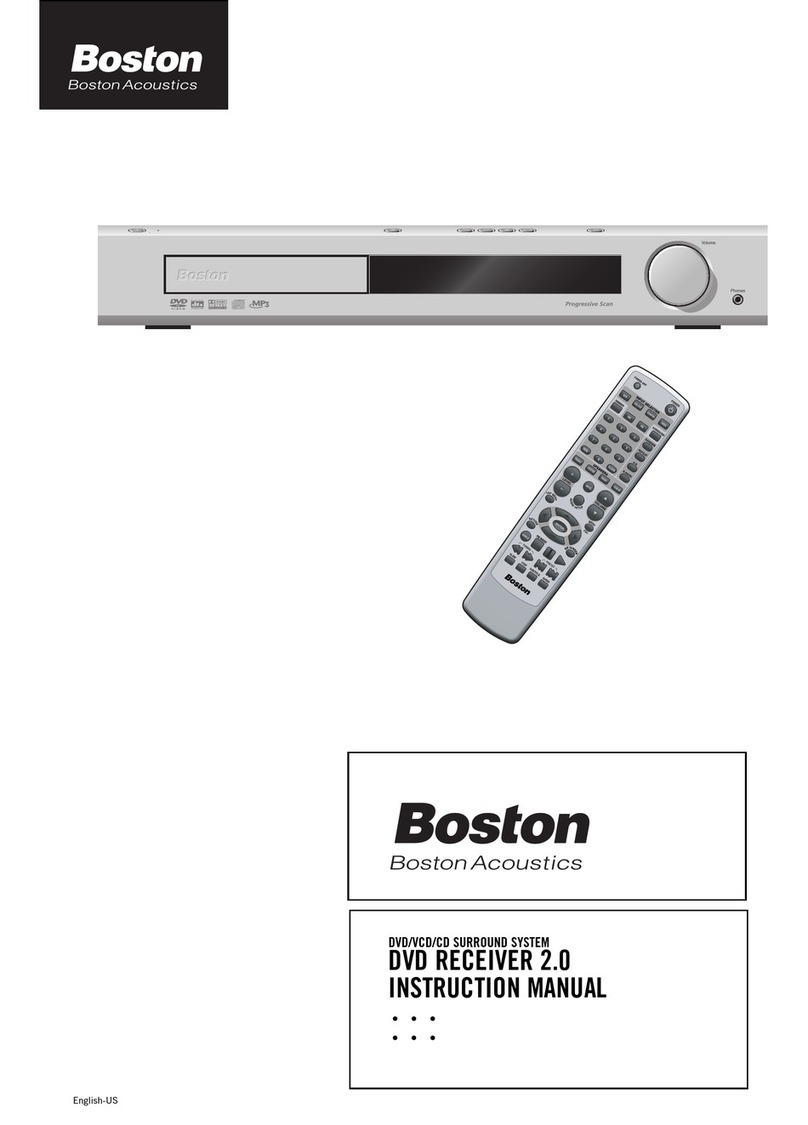
Boston Acoustics
Boston Acoustics Avidea 610 User manual

Boston Acoustics
Boston Acoustics MCS 160 User manual
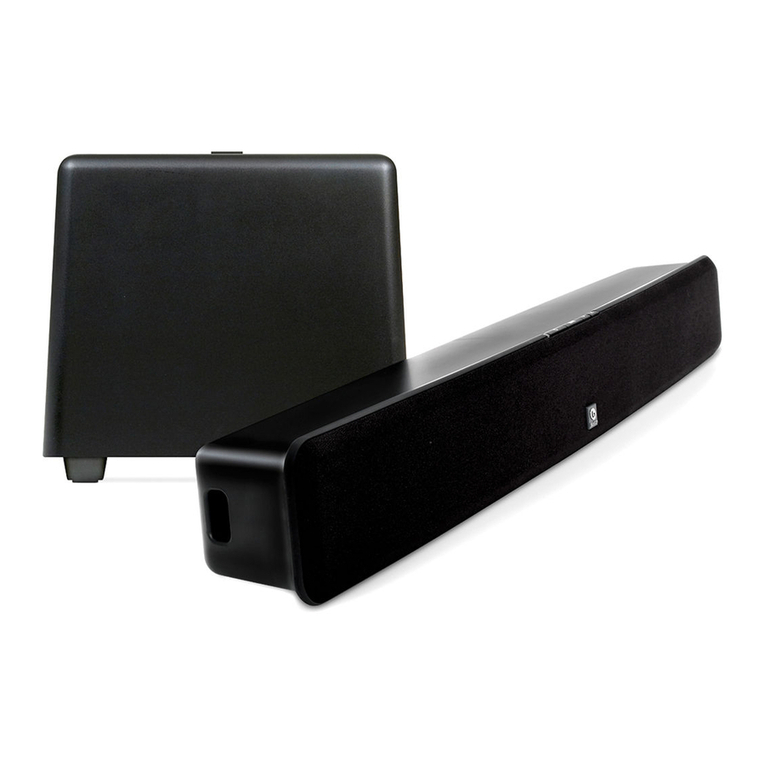
Boston Acoustics
Boston Acoustics TVeeTM User manual
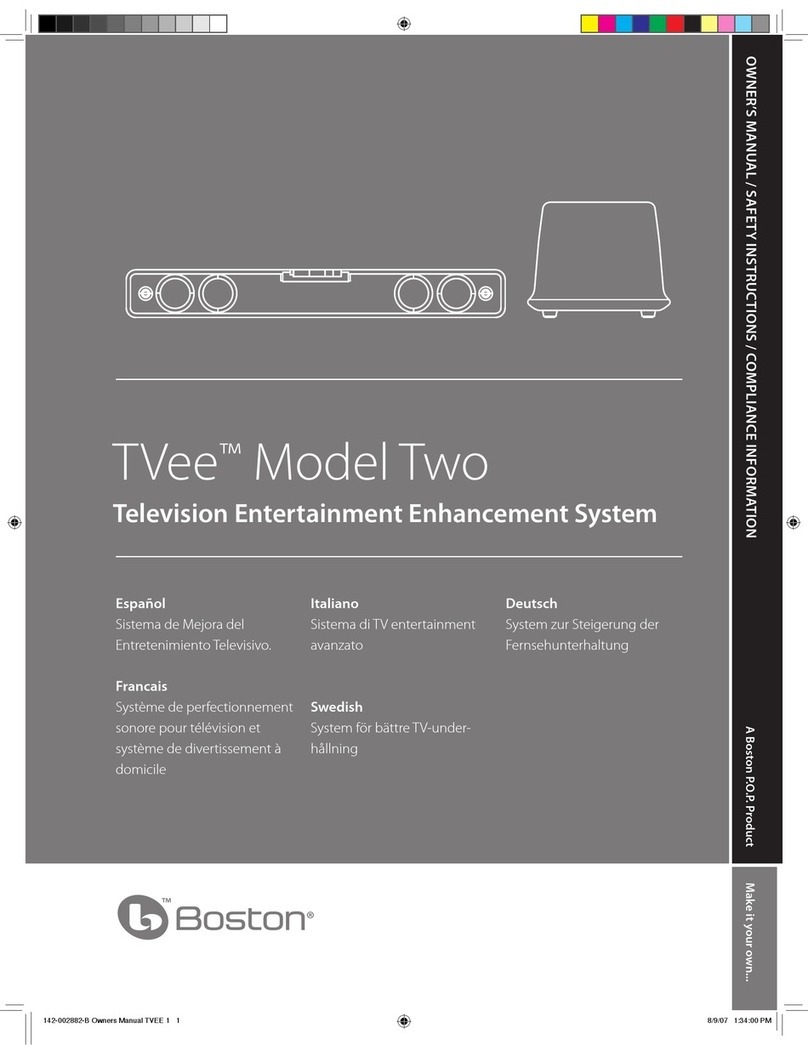
Boston Acoustics
Boston Acoustics TVee Model Two User manual

Boston Acoustics
Boston Acoustics Avidea 610 User manual
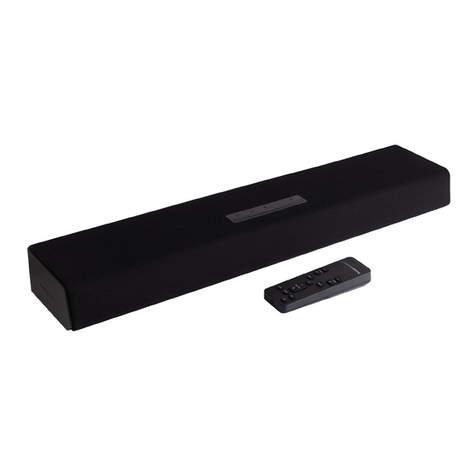
Boston Acoustics
Boston Acoustics TVee 22 User manual

Boston Acoustics
Boston Acoustics TVee 300 User manual
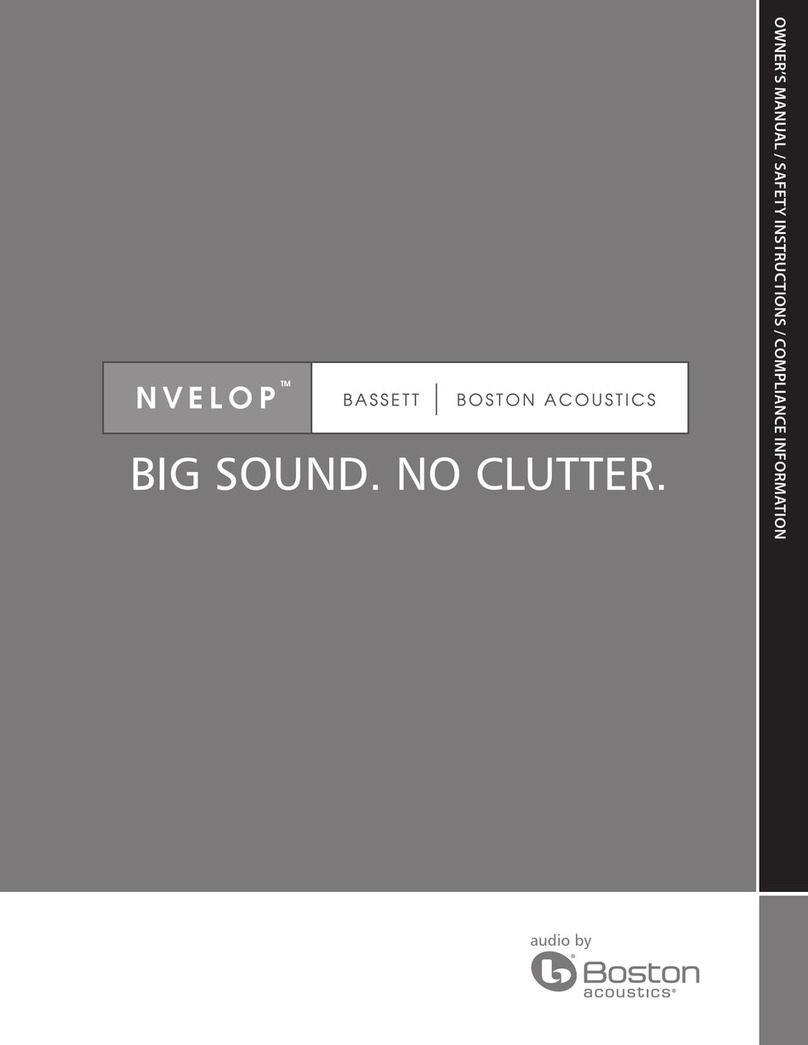
Boston Acoustics
Boston Acoustics Bassett's Nvelop User manual

Boston Acoustics
Boston Acoustics Avidea 610 Technical manual
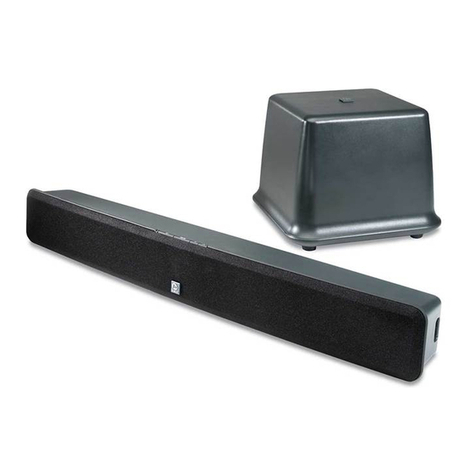
Boston Acoustics
Boston Acoustics TVee Model Two User manual
